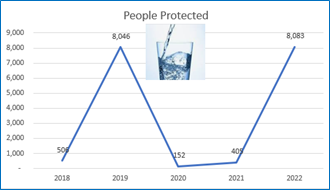Enforcement and Compliance Annual Results for Fiscal Year 2022: Drinking Water

Protecting America’s drinking water is a top priority for EPA. Providing safe drinking water is a partnership that involves EPA, the states, tribes, public water systems and their operators, and certified laboratories that conduct analyses of drinking water samples collected by public water systems.
EPA took aggressive early actions in communities to address drinking water. OECA issued 86 drinking water orders to public water systems of which 15 were emergency orders. The emergency orders, all in overburdened communities, protected over 12,000 individuals; collectively the orders protected over eight million people.
Examples of our drinking water accomplishments in FY 2022 include:
- EPA issued emergency orders under the Safe Drinking Water Act to nine mobile home parks operating public water systems on the Torres Martinez Desert Cahuilla Indians Reservation. The emergency orders require the private operators on the Torres Martinez Tribe’s land to provide alternative drinking water, reduce the levels of arsenic in the system’s water, and monitor the water for contamination.
- EPA took immediate actions in Benton Harbor, Michigan to improve the safety and reliability of its drinking water. EPA required the city to take several actions to protect residents including:
- Informing consumers when lead action level exceedances are detected,
- Implementing stricter requirements for better monitoring, and
- Making filter repairs at the treatment plant.
- EPA with the Jersey City Municipal Utilities Authority (JCMUA), in Jersey City, New Jersey, agreed to a modification of a 2011 consent decree that will significantly improve the city’s drinking water and municipal sewer systems. Among other things, this agreement will accelerate the replacement of thousands of lead service lines serving a population over 250,000, which means cleaner drinking water for overburdened communities and improved protection of children whose health is particularly vulnerable to the impacts of lead.
